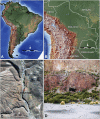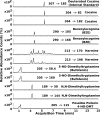Chemical evidence for the use of multiple psychotropic plants in a 1,000-year-old ritual bundle from South America
- PMID: 31061128
- PMCID: PMC6561276
- DOI: 10.1073/pnas.1902174116
Chemical evidence for the use of multiple psychotropic plants in a 1,000-year-old ritual bundle from South America
Abstract
Over several millennia, various native plant species in South America have been used for their healing and psychoactive properties. Chemical analysis of archaeological artifacts provides an opportunity to study the use of psychoactive plants in the past and to better understand ancient botanical knowledge systems. Liquid chromatography tandem mass spectrometry (LC-MS/MS) was used to analyze organic residues from a ritual bundle, radiocarbon dated to approximately 1,000 C.E., recovered from archaeological excavations in a rock shelter located in the Lípez Altiplano of southwestern Bolivia. The site is located at an elevation of ∼3,900 m above sea level and contains evidence of intermittent human occupations during the last 4,000 years. Chemical traces of bufotenine, dimethyltryptamine, harmine, and cocaine, including its degradation product benzoylecgonine, were identified, suggesting that at least three plants containing these compounds were part of the shamanic paraphernalia dating back 1,000 years ago, the largest number of compounds recovered from a single artifact from this area of the world, to date. This is also a documented case of a ritual bundle containing both harmine and dimethyltryptamine, the two primary ingredients of ayahuasca. The presence of multiple plants that come from disparate and distant ecological areas in South America suggests that hallucinogenic plants moved across significant distances and that an intricate botanical knowledge was intrinsic to pre-Columbian ritual practices.
Keywords: archaeometry; exchange; hallucinogen; liquid chromatography mass spectrometry; shamanism.
Conflict of interest statement
The authors declare no conflict of interest.
Figures




Comment in
-
Ancient medicinal plants of South America.Proc Natl Acad Sci U S A. 2019 Jun 4;116(23):11087-11089. doi: 10.1073/pnas.1906805116. Epub 2019 May 21. Proc Natl Acad Sci U S A. 2019. PMID: 31113878 Free PMC article. No abstract available.
References
-
- Wadley G. (2016) How psychoactive drugs shape human culture: A multi-disciplinary perspective. Brain Res Bull 126:138–151. - PubMed
-
- VanPool CS. (2009) The signs of the sacred: Identifying shamans using archaeological evidence. J Anthropol Archaeol 28:177–190.
-
- Goodman J, Lovejoy PE, Sherratt A, eds (1995) Consuming Habits: Drugs in History and Anthropology (Routledge, London: ).
-
- Ruck CAP, Bigwood J, Staples D, Ott J, Wasson RG (1979) Entheogens. J Psychedelic Drugs 11:145–146. - PubMed
-
- Angelo ZD, Capriles JM (2004) La importancia de las plantas psicotrópicas para la economía de intercambio y relaciones de interacción en el altiplano sur andino. Chungara Revista de Antropología Chilena 36:1023–1035.
Publication types
MeSH terms
Substances
LinkOut - more resources
Full Text Sources
Miscellaneous

